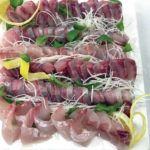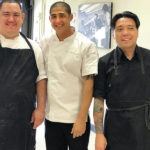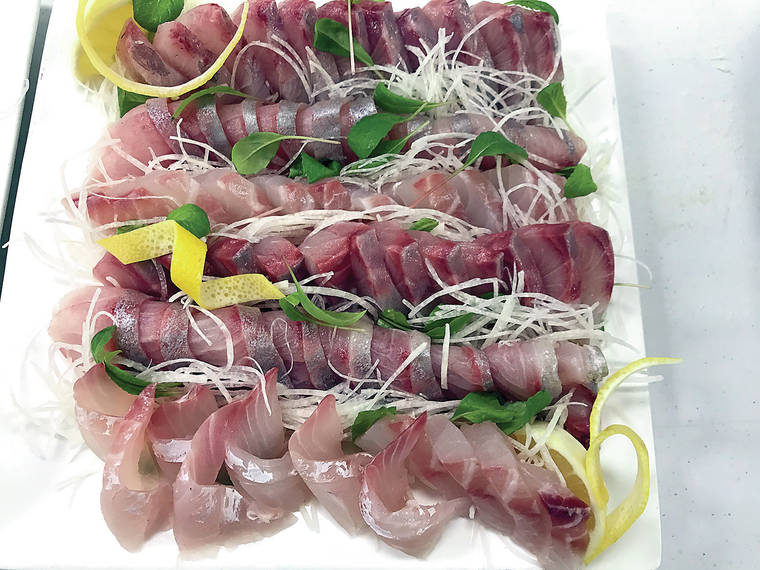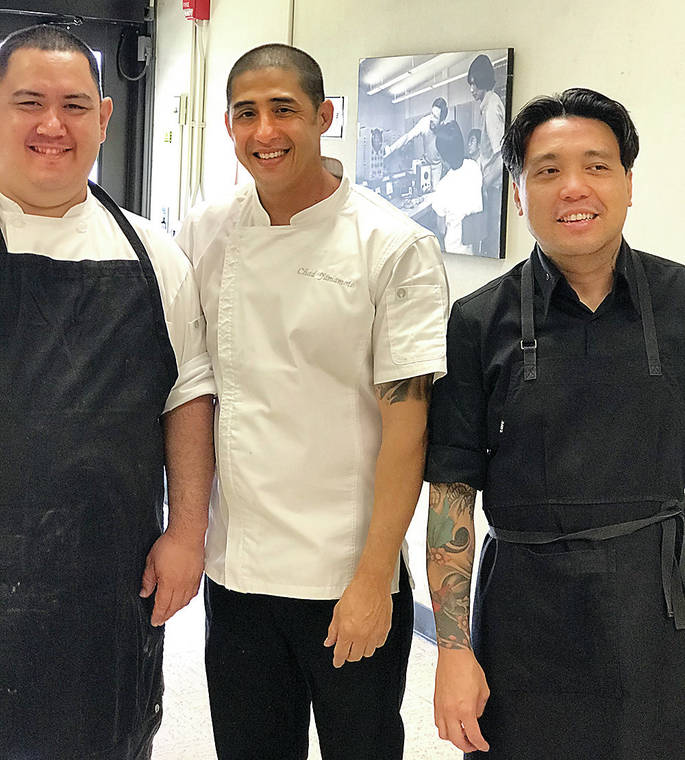Let’s Talk Food: Three chefs visit HCC


Thanks to the Hawaii Culinary Foundation, Chef Chad Yamamoto, presently the executive chef at Merriman’s in Waimea and formerly the Chef de Cuisine for Ulu at the Four Seasons, Hualalai; Nuri Piccio, sushi chef at Ulu at the Four seasons, Hualalai; and Sean Franco also of the Four Seasons, recently worked with the students at Hawaii Community College’s Culinary Arts program.
Nuri Franco, originally from New Jersey, who after culinary school, worked in several sushi restaurants, first as a dishwasher for several years, before being able to learn and hone his skills as a sushi chef. He even maxed out two credit cards to live in Japan so he could work at sushi bars for free to further perfect his art.
ADVERTISING
In 2005 he moved to Maui and was employed by several hotels with sushi restaurants. Then the opportunity came to work at the Four Seasons Hualalai and he has been on the Big Island since. Being of Japanese, Filipino, Italian, and Chinese descent, Nuri said he feels right at home with the beautiful cosmopolitan mixtures of races here in the islands.
Nuri’s story is interesting, as his first love was art, but his wise mother, who did not want to have a starving artist son, suggested he go to culinary school. He did not even know what “culinary” meant but obeyed his mom and has not looked back since. In his second year in college, there was a guest sushi chef who spoke very little English. He watched him in action and then knew where his career would be taking him. He became the dishwasher in his sushi restaurant in Baltimore, Maryland.
Nuri showed the students how to prepare ehu, or Hawaiian red snapper, and Kona kampachi for sushi and sashimi. The beautiful red coloring of the skin of the ehu should not be thrown away but instead be part of the plate. But unlike the red snapper in Japan, the ehu has a rather chewy skin. So Nuri taught the students how to scald the skin in boiling water while the fish sat in a tub of ice. When the skin contracted, it was ready to be sliced into sashimi.
Nuri has had the experience of scalding the skin of the ehu and someone, especially from the mainland, returns the plate of sashimi because there is skin on it. But with the impeccable service of the Four Seasons, he doesn’t say anything but removes the skin. Humility is important in this service industry and Nuri learned quickly.
Twenty-seven years ago, Chad Yamamoto, from Pahoa High School, started his journey by entering Hawaii Community College’s Culinary Arts program in Hilo. Walking through the kitchens and working with the students brought back memories for him. He told the students he was stoked and excited to be there, especially because he remembered sleeping in class and skipping classes. Like Nuri, he also did not know what the word “culinary” meant but went into the program anyway. This was a life changer as cooking became a passion and in this field, “you just got to want it!”
Chef Chad left the students saying they needed to keep a great attitude and be positive in this field as it is hard work.
Chef Sean said he works 60 hours a week and you have to have a passion for cooking, otherwise you won’t make it.
I am not a huge gnocchi fan because most of what I have eaten has been starchy and chewy. Chef Chad, with the assistance of Sean Franco, who also was a graduate of the HCC Culinary Arts program, made gnocchi that they make at the Four Seasons Hualalai that melts in your mouth.
After sampling his gnocchi, I will try eating gnocchi again!
Potato Gnocchi
Makes 12 servings
3 pounds russet potatoes
2 cups Caputo “OO” Italian flour
1 whole egg
Preheat oven to 350 degrees.
Wash potatoes, place them on a sheet pan with salt covering the top and bottom of the potatoes. (The salt draws moisture out of the potatoes — important in making good gnocchi).
Bake potatoes for 45 minutes or until soft.
Cool slightly and peel the potatoes using a paring knife.
Run skinned potatoes through a ricer. If ricer is not available, mash with a fork.
Beat egg and add potatoes. Add flour slowly, you do not add all 2 cups otherwise the gnocchi will be hard. Use the rest of the flour to scatter on the board to knead.
Gently knead all ingredients until slightly firm and let rest for 10 minutes to let gluten form.
Cut dough with a bench scraper, roll into 1/2-inch thick logs and cut into 1/2-inch pieces. Press each piece against your thumb tip to make a dent or roll over a gnocchi board or fork.
Cook gnocchi in boiling water (salty like the sea). When gnocchi floats to the top, cook for 2 minutes longer and remove with a slotted spoon.
Gnocchi Sauce:
Brown Butter Sage
8 tablespoons salted butter
4 sage leaves, thinly sliced
1/2 teaspoon black pepper
1/2 cup shaved or coarsely grated Parmesan cheese
Melt butter in a large skillet over high heat. Cook, stirring until the butter develops brown flecks and smells nutty. Watch it closely to keep the butter solids from burning. Remove from the heat.
Chef Chad and Sean also made fresh pasta and cut them into tagliatelle, pappardelle, and chitarra.
Foodie bites
The Hawaii Community College’s Culinary Arts program’s Bamboo Hales is open today, closed tomorrow, open Thursday and Friday with the Asian Standard menu and the foods of China.
Call 934-2591 for reservations. Seating is from 11 a.m. to 1 p.m. The Cafeteria is open from 10:30 a.m. to 12:20 p.m. Call 934-2559 for specials of the day and take out orders.
Email Audrey Wilson at audreywilson808@gmail.com.



